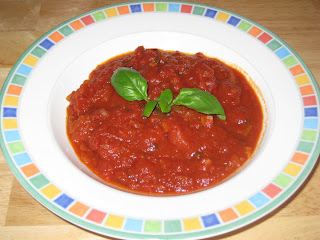Hello World!
I'm Antonietta and I'm here to share my stories and recipes with you. But first a little story to explain the name Cipolli.
Hope you like it!
CipolliSo there I was, in Gian Luca’s tiny West Philadelphia apartment, trying to recreate one of my mother’s recipes. I wasn’t making anything fancy; my dish only had four simple ingredients, yet, I was hoping that somehow, I could make something that would impress him, something that would make him feel at home.
He arrived from Italy shortly beforehand and we had met only once, at a dinner with friends earlier that week. He had a carefree playfulness and genuine smile, yet an air of mystery. I wanted to learn more about him.
“How long are you staying?” I had asked that night.
“Six months.”
“Wow,” I said remembering the two times I had lived abroad. Moving was always exciting but after a while I longed for something familiar. “Do you think you’ll miss Italy?”
“I don’t think so,” he said, but I could tell by his distant gaze that there were things he already missed.
Later in the week, a mass email arrived. Gian Luca wanted to invite everyone to his apartment for lunch on Sunday. Then, later, another email, this time to a smaller list: he needed help.
On Sunday I drove to Philadelphia with folding chairs in my trunk and a giddy feeling in my stomach. Why had he asked me for help? I searched my thoughts trying to remember if I had told him that my family had a restaurant, or that cooking was a passion of mine. Or had he just known?
I decided to make onion focaccia, the unexpected crowd pleaser. My mother began making this dish in 1989 when she first opened her restaurant and introduced gourmet food to our small town in New Jersey.
At first, people were hesitant to try the thin crust topped with caramelized onions and golden pecorino cheese. “Onions on pizza?” I heard our first customers say. “Where’s the tomato sauce? Where’s the cheese?”
Even at eight years old I realized what it meant to be an adventurous eater and I was grateful that my mother had introduced us to unusual foods. I wanted to laugh at these customers and tell them how good it was.
My mother had a more subtle approach. She would cut a slice into small strips, hand out samples and let the food speak for itself.
Soon, people were lining up for a piping hot piece of “onion pizza” which my mother would serve Roman style—cut into large squares that were folded together and consumed like a sandwich.
In Rome, this type of pizza is called Pizza al Taglio, and it makes for a quick lunch or afternoon snack. When I spent a semester there during college I would often join my friends for a small slice between classes, trying a different topping each day. They were amazed by the crunchy texture of the dough, vastly different from the soggy American pizza they were used to. But to me, each bite brought me right back home, to the noisy kitchen of the restaurant where I spent most of my childhood.
There were four of us cooking that afternoon. Michelle was making bowtie pasta with smoked salmon and crème sauce, Enea was in charge of searing the steak, I was on appetizers and Gian Luca was bouncing between all of us, helping wherever he could and trying to figure out how he was going to fit twelve people in his studio apartment.
I was the only American in the room and yet, I was confident in my cooking abilities. I took over the tiny kitchen table, opening my bag of groceries and laying out all of the ingredients. I methodically sliced the onions without shedding a tear, then placed a small sheet pan on the tabletop and smeared it with the Crisco I had brought from home. Next I began stretching the dough over the pan, pressing it thin so that it would crisp while baking. As I worked, Gian Luca and Enea discussed, in rapid Italian, where they were going to put everyone.
Finally, it was decided that the kitchen table should be connected with Gian Luca’s desk and arranged on a diagonal cutting across the apartment. The folding chairs that I had brought, along with the three kitchen chairs would sit on one side of the table, the bed would act as a makeshift bench for the other side. The men started arranging the furniture.
My back was turned as they took the table with all of my ingredients into the other part of the room. My pan on the stove was already filled with golden olive oil, ready to bring out the sweetness in the onions. When I turned around to reach for them, the table was gone. I thought I would impress Gian Luca by asking for the onions in his native tongue. “Scusi, mi poi passare i cipolli?”
I heard them laugh and wondered if I had stumbled across another Italian double meaning. It seems that whenever I thought I was asking for a household item I would blurt out some dirty euphemism that made people smirk. “What?” I asked. “Why are you laughing?”
Gian Luca approached me with the cutting board full of onions. “Here are your cipoliiiiiii,” he said, dragging the final i sound like nails on a chalkboard.
I grabbed the cutting board and looked at Michelle for help.
“Its cipolle,” she said shooting him a dirty look. “Onions are feminine.”
I felt my face getting flushed. I should have studied Italian more in college, should have paid more attention to my mother all the times she tried to correct my pronunciation. But I was a hopeless case; no matter how hard I tried I could never remember what gender belonged to what words. Why are onions female? Why is an oven male? I just didn’t get it.
I dropped the onions in the hot oil and listened to them sizzle.
“Don’t worry,” Michelle said. “They mess up their English all the time.” I knew that this was true because I had spoken to them predominantly in English and heard their mistakes, but still, I wished to speak effortlessly, to pass for a real Italian, the kind that Gian Luca could fall for.
“Cipolli,” he called from the other room. I lowered the flame and stirred my onions. They were becoming translucent. “Cipolli,” he called again and I understood that this would be my new nickname. I ignored him.
“Dai,” he said walking into the kitchen. “Come on Cipolli, I am joking.” I stared down at the onions and continued to stir. “ I think your accent is cute.” My heart fluttered. By the time I had looked up from the pan he was already in the other room.
I turned off the heat and walked over to get my pizza dough. Enea and Gian Luca looked over at me.
“Cipolli, I like the name for you,” Enea said.
“Yes, you are really Cipolli,” Gian Luca agreed.
I smiled and took it as a good sign. Onions are feminine.
Back in the kitchen I poured the caramelized onions and olive oil on top of the dough then finished it with some grated pecorino. I popped the focaccia into the oven and helped Michelle with the dishes. Soon the sweet and salty smell of the focaccia filled the apartment. Our friends started arriving with wet coats and cold hands. They undressed a few layers, grabbed a glass of wine and inhaled deep breaths of the faintly familiar aroma.
The volume in the room got louder as more wine was being uncorked. People were talking rapidly in both English and Italian, laughing and signing along to the Italian music that was playing. Our friends took their seats around the table and, miraculously, everyone fit.
I pulled the focaccia out of the oven. The crust was golden, the onions had merged into the dough and the tiny specks of pecorino had browned in the heat. It looked exactly like my mom’s. I ran a knife through it, listening to the crackle of the crispy crust as I cut tiny strips out of the large pie. I placed it on a serving dish, brought it to the table, and let the food speak for itself.
I watched as Gian Luca took a bite. His eyes widened. He looked at me and smiled. I knew that without words, I had taken him home.





